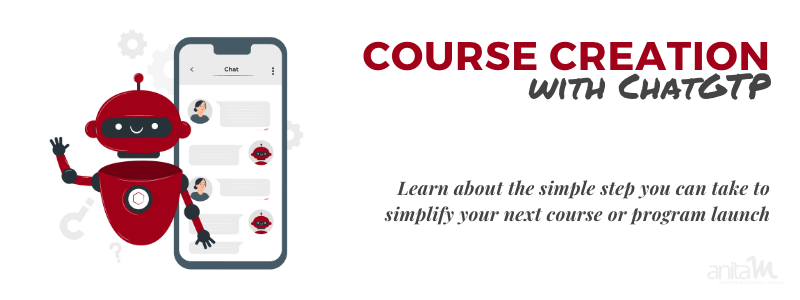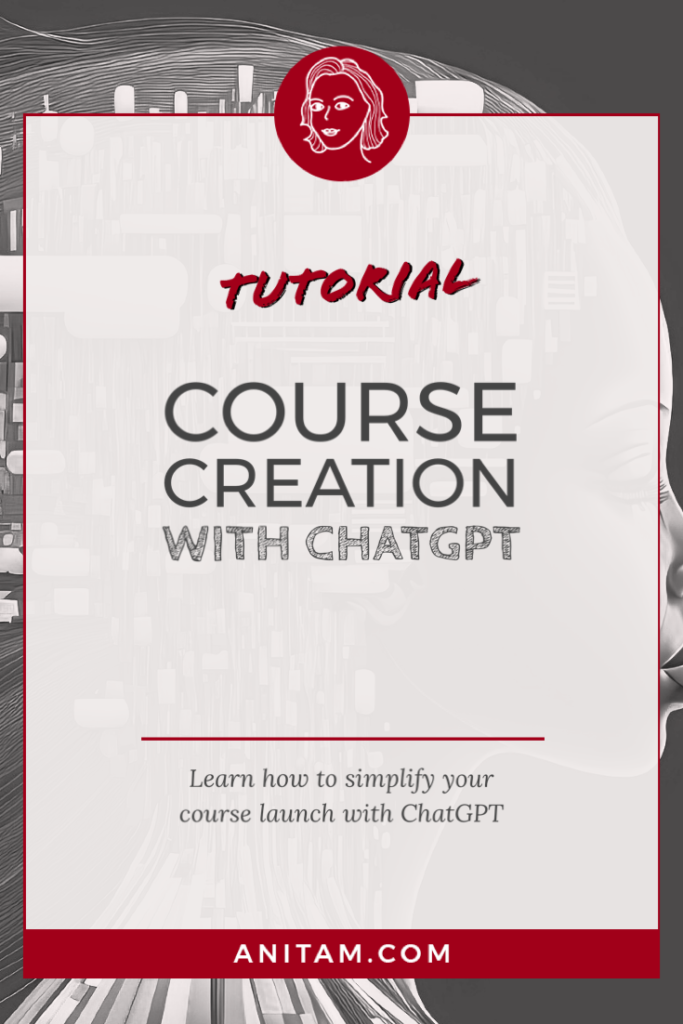Course creation can often feel like an overwhelming and time-consuming endeavor, leaving course creators searching for innovative solutions to streamline the process. Fortunately, there’s a game-changing tool that can make course creation a breeze: ChatGPT. As an advanced AI language model, ChatGPT empowers course creators to generate unique course ideas and produce high-quality content with remarkable speed and ease.

With its intelligent prompt generation capabilities, ChatGPT offers endless possibilities for various course types, including online courses, corporate training programs, professional development courses, continuing education courses, and skill-based courses. In this article, I will delve into the remarkable benefits of leveraging ChatGPT prompts in course creation and outline the essential steps to embark on your course creation journey with confidence and efficiency. Get ready to unlock a new world of course creation with ChatGPT!
What is ChatGPT?
ChatGPT is a language model developed by OpenAI that uses natural language processing and machine learning to generate human-like responses to prompts. Prompt engineering is the process of crafting prompts that elicit specific types of responses from ChatGPT. This technology can be a game-changer for course creators who want to streamline their content creation process and generate new ideas for their courses.
The Benefits of Using ChatGPT to Create Courses
There are several benefits of using ChatGPT prompts to create courses:
Speed and Efficiency: ChatGPT can generate content quickly and efficiently, saving course creators time and effort in developing high-quality course content.
Quality Content: ChatGPT can generate high-quality content that is informative, engaging, and aligned with learners’ needs and preferences.
Diverse Perspectives: ChatGPT can generate prompts from a variety of perspectives, helping course creators explore different angles and approaches to their topic.
Personalization: ChatGPT prompts can be customized to fit specific needs and preferences, helping course creators tailor their content to their learners.
Inspiration: ChatGPT prompts can spark new ideas and creativity, helping course creators break through writer’s block and generate fresh content.
In addition, ChatGPT can help you create a wide range of online courses that are tailored to your specific needs and goals, whether you’re an educator, a corporate trainer, or an individual looking to expand your skill set.
✅ Online Courses
ChatGPT can generate content for online courses that are delivered through e-learning platforms, such as Moodle, Blackboard, or Canvas. These courses can include text, audio, and video content, as well as interactive quizzes and assessments.
✅ Corporate Training & Onboarding
ChatGPT can help create corporate training courses that are tailored to the specific needs of your organization. These courses can include content on leadership, communication, project management, and other topics relevant to the workplace.
✅ Professional Development
ChatGPT can generate content for professional development courses that are designed to help individuals acquire new skills and knowledge in their field. These courses can be used to meet certification requirements or simply to stay up-to-date with the latest trends and developments in a particular industry.
✅ Continuing Education Courses
ChatGPT can create content for continuing education courses that are designed for learners who want to continue their education beyond their formal schooling. These courses can be used to fulfill licensing or certification requirements, or simply to pursue personal interests.
✅ Skill-based Courses
ChatGPT can help create skill-based courses that focus on developing specific skills, such as writing, programming, or design. These courses can include practical exercises and hands-on learning opportunities to help students develop mastery in their chosen skill.
Best Course Types to Create with ChatGPT
As you already know, with ChatGPT, you can create a wide range of interactive conversational courses in just a matter of minutes. Here are some of the best course types you can create using ChatGPT:
Interactive Tutorials: With ChatGPT, you can create step-by-step tutorials that guide learners through a particular task or teach them a new skill. These tutorials are designed to be engaging and interactive, allowing learners to ask questions and receive feedback in real-time.
Decision-Making Courses: ChatGPT can also help you create courses that teach learners how to make better decisions by providing them with a structured decision-making process. These courses are ideal for professionals who need to make complex decisions on a regular basis.
Problem-Solving Courses: If you’re looking to help learners identify and solve problems, then ChatGPT can help you create courses that provide them with a structured problem-solving framework. These courses are great for professionals in industries like engineering, IT, and healthcare.
Learning Sessions: With ChatGPT, you can create courses that provide learners with an interactive learning experience that includes quizzes, videos, and other learning materials. These courses are perfect for educators who want to create engaging online learning experiences.
Simulation Courses: Finally, ChatGPT can help you create simulation courses that simulate real-world scenarios and allow learners to practice their skills in a safe environment. These courses are ideal for professionals in industries like aviation, engineering, and healthcare.
Overall, ChatGPT is a versatile and powerful platform that can help you create a wide range of engaging and interactive courses. Whether you’re an educator or a professional looking to improve your skills, ChatGPT has everything you need to create high-quality courses quickly and easily.
Course Creation with ChatGPT
Getting started with creating a course using ChatGPT prompts is easy and straightforward. Here are the steps you can follow:
STEP 1: Define your course topic and goals
The first step is to define the topic and goals of your course. This will help you generate prompts that are relevant to your course and aligned with your objectives.
STEP 2: Start your course creation with ChatGPT
Once you have defined your course topic, input it into ChatGPT to generate prompts. You can use different prompts to explore various angles and perspectives on your topic.
STEP 3: Refine and customize the prompts
Once you have generated prompts, review them and refine them to fit your specific needs and preferences. You can customize the prompts by adding or removing content, changing the tone, or adding your own examples and anecdotes.
STEP 4: Organize your course content
Once you have refined your prompts, organize them into a coherent structure that flows logically and engages your learners. You can use ChatGPT to generate headings and subheadings, as well as bullet points and summaries to help organize your content.
STEP 5: Add multimedia and interactive elements
To create an engaging and interactive course, consider adding multimedia elements such as videos, images, and audio recordings. You can also create quizzes, assessments, and interactive exercises to help reinforce learning and measure progress.
STEP 6: Test and revise your course
Once you have created your course content, test it with a small group of learners and revise it based on their feedback. This will help you ensure that your course is engaging, informative, and aligned with your learners’ needs and preferences.
Prompts to Enhance Course Creation with ChatGPT
Role Prompting: Use prompts that ask ChatGPT to take on the role of a specific character or persona, such as a student, expert, or mentor. This will help you generate content from different perspectives and make your course more relatable to your target audience.
Use Descriptive Adjectives: Incorporate descriptive adjectives in your prompts to help ChatGPT create more vivid and engaging content. For example, instead of asking for “tips for writing,” ask for “creative and effective writing tips.”
Avoid Open-Ended Prompts: Instead of using open-ended prompts, provide specific details or parameters to guide ChatGPT’s response. This will help you generate more relevant and focused content.
Simplify Complex Concepts: Use prompts to help simplify complex concepts and make them more accessible to learners. ChatGPT can help break down difficult concepts into easy-to-understand language, making your course more approachable for learners.
Create Stories for Content: Storytelling is a powerful tool for engaging learners and making course content more memorable. Use prompts to generate stories or examples that illustrate key concepts or ideas in your course.
Introduce Fun Sections: Use prompts to create fun and interactive sections in your course, such as quizzes, games, or challenges. ChatGPT can help generate creative ideas for these sections that will keep learners engaged and motivated.
Use as a Translation Tool: ChatGPT can also be used as a translation tool to help create course content in multiple languages. Use prompts to generate content in one language and then translate it into other languages with ChatGPT’s help.
Format the Output: Use prompts to generate content that fits your preferred formatting style, such as bullet points, headings, or paragraphs. This will help you save time and effort in formatting the content yourself.
Build a Personal Style Guide: Use prompts to generate content that aligns with your personal style guide for your course. This will help ensure consistency and coherence in your course content.
Create Tasks from Prompts: Use prompts to generate tasks or assignments for learners, such as essays, reports, or projects. ChatGPT can help generate creative ideas for these tasks that align with your course objectives.
While this barely touches what you can do with ChatGPT, I have created a copy & paste library of 150+ ChatGPT prompts & course launch framework that can expedite your course creation process.
Examples of Courses Created with Chat GTP
While ChatGPT is a powerful tool for generating course ideas and content, it is important to note that it is not a complete course creation solution on its own. However, it can be used as a valuable tool to assist in the creation of a variety of different types of courses.
Here are a few examples of courses that could be created with the help of ChatGPT:
“Introduction to Coding”: This course could be designed to teach the basics of programming, with ChatGPT generating prompts and content to help guide students through the course material. The course could include interactive coding challenges and quizzes to reinforce learning.
“Leadership Development for Managers”: This corporate training course could be tailored to the specific needs of a business, with ChatGPT generating content related to leadership development and management techniques. The course could include case studies and real-world scenarios to help managers apply the concepts they learn.
“Digital Marketing Fundamentals”: This professional development course could be designed to teach individuals the basics of digital marketing, with ChatGPT generating prompts and content related to topics like SEO, social media marketing, and email marketing. The course could include interactive quizzes and assessments to help learners test their knowledge.
“Introduction to Psychology”: This continuing education course could be designed to provide an overview of the field of psychology, with ChatGPT generating content related to topics like human behavior, cognition, and mental health. The course could include videos, podcasts, and other multimedia content to engage learners.
“Graphic Design Basics”: This skill-based course could be designed to teach the fundamentals of graphic design, with ChatGPT generating prompts and content related to topics like color theory, typography, and layout design. The course could include practical exercises and projects to help students develop their skills.
As you can see, pretty much any topic or course can benefit from Chat GTP assistance. And while this approach to course creation may be very helpful, it’s important to remember that as course creator, it’s your duty to ensure that your content is of highest quality, and therefore review and revision of the generated content should be of highest priority before course launch.

In conclusion, creating a course using ChatGPT prompts is a simple and efficient process that can save you time and effort in generating high-quality course content. By following the steps outlined in this article, you can create engaging and informative courses that align with your learners’ needs and preferences. With ChatGPT’s help, course creation can be easy.
This article first appeared on Medium and it reflects my personal views and opinions.
